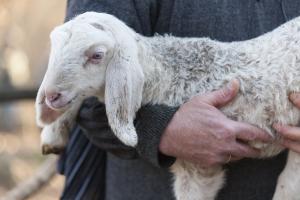Watching the Flock
The flocks of contemporary shepherds contain both sheep and goats. Although both were called "small cattle" in Hebrew, clear differences distinguish them. For instance, goats are generally dark and aggressive, while sheep are usually lighter colored, docile, and passive. Sheep eat grass to an even height, while goats graze much closer to the ground and also eat leaves, bark, and fruit.
Occasionally, shepherds separate the sheep and goats, possibly to protect young trees or other crops growing nearby. This difficult task and the goats? bad reputation are expressed in the New Testament. Interestingly, Jesus used the shepherds' process of separating sheep from goats to describe judgment day (Matt. 25:32-33).
The wilderness is an extremely mountainous country with hidden canyons (wadis) hundreds of feet deep. Hikers are aware of the danger of following trails along these steep slopes. Blinded by the bright sun, they could suddenly find themselves at the rim of a deep canyon with its edge obscured in shadows.
Shepherds in Israel often pastured sheep along these steep canyons. Sometimes the trails would lead to the edge of a cliff where the only escape was to retreat. Therefore, an important aspect of protecting the flock involved knowing when the paths ahead followed along the canyon edge.
Such an experience is detailed in Psalm 23:4 where it reads: "Even though I walk through the darkest valley or the darkest shadow" (NIV: "through the valley of the shadow of death"). This passage reflects the shepherd's awareness of steep canyons and difficult paths as he leads his flock to green pastures and quiet water.
Â




